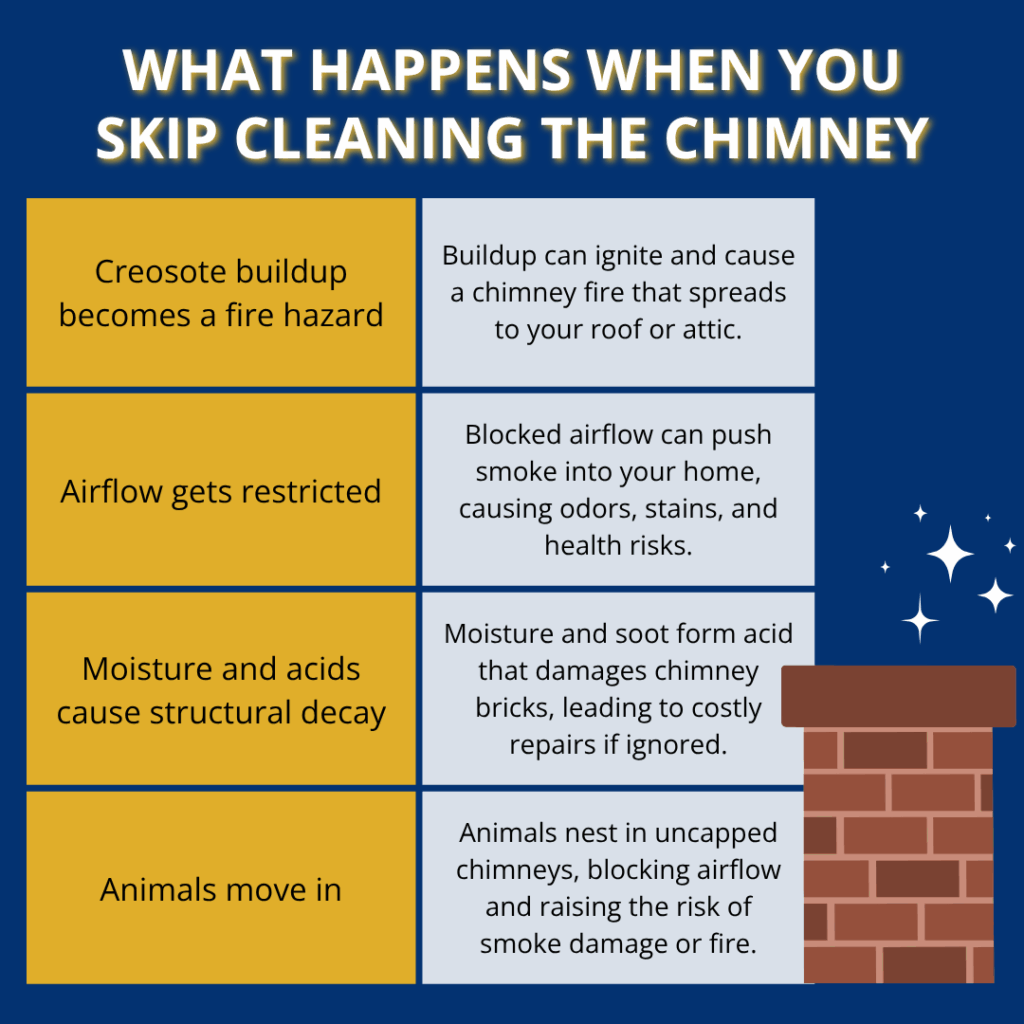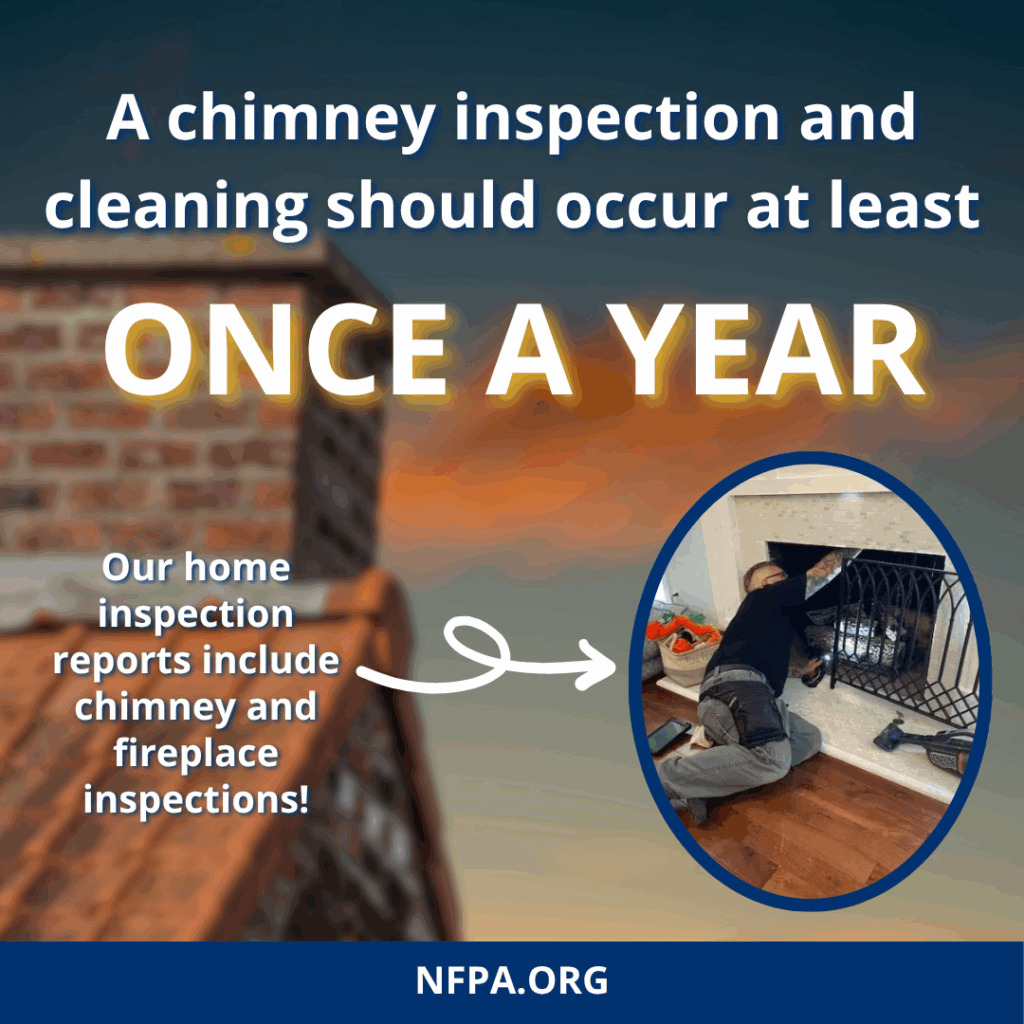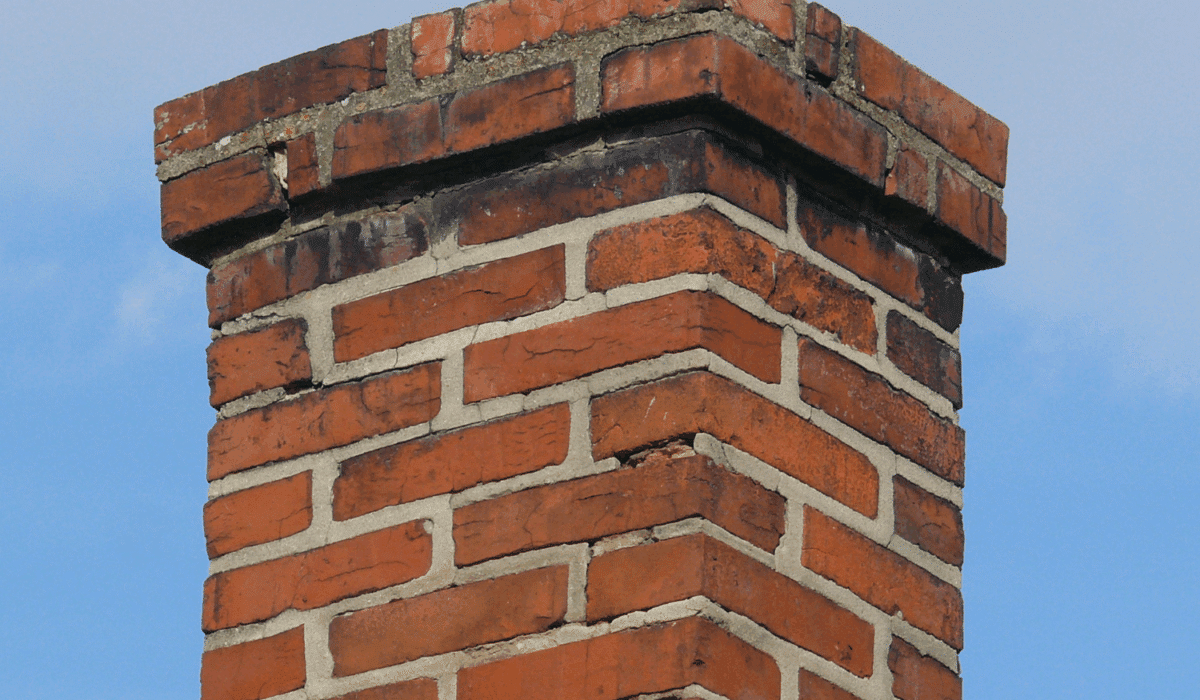A clean chimney isn’t just for looks; it’s one of the most important ways to protect your home. Each time you burn wood, smoke and gases rise through the chimney, leaving behind residue known as creosote. Over time, that buildup can lead to serious issues like chimney fires, smoke damage, and even carbon monoxide leaks.
Cleaning the chimney early, before you start using your fireplace for the season, helps stop these problems before they start. It allows professionals to clear dangerous buildup, check for damage, and make sure your fireplace system runs safely and efficiently.
Homeowners who make this part of their yearly routine often avoid costly repairs and enjoy more peace of mind during the colder months.
What Happens When You Skip Cleaning the Chimney
Skipping chimney cleaning might not seem like a big deal, but the consequences add up fast. Over time, debris, soot, and creosote can clog the chimney, trap moisture, and even lead to structural damage. Here’s what typically happens when cleaning is delayed:

Creosote buildup becomes a fire hazard
As you use your fireplace, small amounts of creosote coat the chimney’s interior walls. If not removed, it thickens and hardens into a tar-like layer. This substance is extremely flammable. Just one stray spark or high temperature can ignite it, leading to a chimney fire that may spread to your attic or roof.
Airflow gets restricted
When soot and residue block airflow, smoke can’t exit properly. That means smoke, soot, and even carbon monoxide can seep into your living room. Besides creating a lingering odor, this buildup can cause health problems and smoke stains on nearby walls or ceilings.
Moisture and acids cause structural decay
Moisture from rain or snow can mix with soot, creating an acidic layer that eats away at bricks and mortar. Over time, this weakens the chimney and leads to crumbling masonry. The more it’s ignored, the more expensive it becomes to repair.
Animals move in
Birds, squirrels, and even raccoons often make their homes in chimneys that aren’t cleaned or capped. Their nests can block airflow and increase the risk of smoke damage or fires.
Delaying cleaning doesn’t just risk safety; it can also make home inspections less accurate. Soot and buildup can hide cracks or leaks that might otherwise be caught early.
Common Home Defects Prevented by Cleaning the Chimney Early
Cleaning the chimney on time prevents several hidden defects that can turn into major repair projects if ignored. Let’s take a closer look at the most common ones.
1. Cracked Chimney Liner
The chimney liner protects your home by containing heat and smoke as they travel up the flue. When creosote buildup ignites or the chimney gets too hot, the liner can crack or warp. Once damaged, heat and gases can escape into nearby materials, increasing the risk of fire and structural damage.
What Happens If It’s Delayed: Cracks in the liner often go unnoticed until a professional inspection. A damaged liner allows smoke to leak into walls or attic spaces, causing long-term odor and air quality issues. In the worst cases, it can even ignite nearby framing.
Prevention Tip: Cleaning the chimney once a year removes flammable residue before it can damage the liner. It also lets a professional spot early cracks or weak spots before they turn into a hazard.
2. Damaged Masonry or Mortar Joints
The bricks and mortar that make up your chimney can weaken when exposed to acidic soot or moisture. Over time, small cracks form and expand as water freezes and thaws. You might start to see white stains (efflorescence), crumbling mortar, or water leaks around the chimney base.
What Happens If It’s Delayed: As the damage spreads, the structure becomes unstable, leading to leaks into the attic or roof. The longer moisture sits inside, the greater the chance of mold or wood rot.
Prevention Tip: Regular chimney cleaning removes soot and residue that speed up brick decay. Cleanings also make it easier for a chimney professional or home inspector to identify early cracks that can be sealed before freezing weather makes them worse.
3. Blocked Flue and Smoke Damage
A blocked flue is another common issue that cleaning helps prevent. The flue serves as the chimney’s airway, allowing smoke and gases to escape safely. When soot, creosote, or debris builds up, it blocks this passage, forcing smoke back into your home.
What Happens If It’s Delayed: Smoke damage can spread to nearby walls, ceilings, and furniture. Carbon monoxide buildup becomes a real risk since the gas has nowhere to go. Homeowners may also notice lingering odors and reduced heating efficiency.
Prevention Tip: Have your chimney checked and cleaned before winter. Cleaning keeps the flue clear and ensures that dangerous gases vent properly. Installing a chimney cap can also help prevent leaves, twigs, or animal nests from blocking the passage.
4. Roof and Attic Damage from Chimney Leaks
Chimney leaks are one of the leading causes of roof and attic water damage. Over time, cracks in the crown, gaps in the flashing, or missing caps allow water to seep in. When combined with soot and debris, this moisture can lead to rust, rot, and mold growth inside your attic.
What Happens If It’s Delayed: Water stains may appear on ceilings or walls, and insulation can become damp and ineffective. Left unchecked, this can lead to significant roof repairs and even structural damage.
Prevention Tip: Cleaning the chimney early gives professionals a chance to inspect for signs of leaks or broken flashing. A properly sealed and maintained chimney keeps water out and prevents long-term roof deterioration.
What Happens When Cleaning the Chimney Is Delayed
Delaying chimney cleaning might seem harmless at first, especially if you only use your fireplace occasionally, but the damage starts quietly and builds up over time.
In the first few months, soot and light creosote begin to coat the chimney walls. The buildup slightly reduces airflow, making your fires burn less efficiently. By the end of the first year without cleaning, that residue thickens and becomes a strong fire hazard.
After two years, the sticky creosote can harden into a thick layer that’s difficult to remove. This also traps moisture, which starts eating away at the chimney liner and brickwork. Small cracks begin to form, and leaks become more likely.
By the third year, homeowners may start to see visible issues such as stains, crumbling mortar, or smoke leaks. At this point, cleaning alone might not solve the problem; repairs to the liner or masonry could be necessary.
Simply put, the longer cleaning is delayed, the higher the repair costs and the greater the safety risks. Regular cleaning prevents these issues, keeps your fireplace efficient, and saves money in the long run.

Signs It’s Time to Schedule Chimney Cleaning
Not sure when to schedule your next cleaning? Watch for these signs:
- Thick black soot or creosote around the fireplace opening
- Smoke is entering the room instead of rising through the chimney
- Strong smoky or musty odors even when not in use
- Animal noises or visible debris inside the chimney
- Oily or sticky residue on the fireplace walls
- It’s been more than a year since your last professional cleaning
How Often Should You Clean the Chimney?
The National Fire Protection Association (NFPA) recommends a chimney inspection and cleaning at least once a year, or more often if you use your fireplace heavily. Regular cleanings not only remove flammable buildup but also make it easier for professionals to identify damage early.
Timing Tip: Schedule your cleaning in early fall before temperatures drop. This helps you avoid the busy winter season and ensures your fireplace is safe and ready to use.
How Cleaning the Chimney Supports a Professional Home Inspection
A clean chimney helps your home inspector do a better job. When soot and debris block their view, it’s hard to identify cracks, leaks, or other structural issues inside the flue. A freshly cleaned chimney allows inspectors to check every part, from the liner and crown to the damper and smoke chamber.
During a home inspection, professionals look for:
- Cracks in the chimney liner or masonry
- Water stains or leaks near the flashing
- Signs of previous fires or heat damage
- Blocked or rusted dampers
At Edifice Inspections, our trained inspectors carefully assess chimneys as part of a full home inspection. We make sure homeowners know the condition of their fireplace system and can plan maintenance before problems grow. Identifying chimney issues early helps avoid costly repairs later and ensures your home stays safe and efficient.
Simple Prevention Tips for Homeowners
Maintaining your chimney is easier than it sounds. A little attention each year keeps your system in top shape and protects your home from fire and water damage.
Here are simple steps you can take:
- Schedule yearly inspections. Have a certified chimney sweep inspect and clean your chimney once a year, preferably before winter.
- Install a chimney cap. It keeps out rain, leaves, and animals, reducing the chance of blockages.
- Check flashing and mortar. Look for cracks, loose bricks, or gaps after major weather events.
- Burn dry, seasoned wood. It produces less creosote and burns cleaner, reducing buildup.
- Keep records of service. A log of cleanings and repairs helps track maintenance and adds value when selling your home.
These steps, combined with regular inspections, can extend your chimney’s lifespan and keep your fireplace performing safely for years to come.
Related Questions
How often should I clean my chimney to avoid defects?
At least once a year. If you use your fireplace often, consider scheduling two cleanings: one before and one after the winter season.
What happens if I don’t clean my chimney before winter?
Creosote buildup hardens over time, making it harder and more expensive to remove. It also increases the risk of chimney fires and smoke leaks.
Can a home inspection reveal chimney damage?
Yes. A clean chimney helps inspectors spot foundation cracks, leaks, and other signs of wear that may not be visible otherwise.
Is cleaning the chimney enough to prevent fires?
Cleaning removes flammable and carbon monoxide buildup, but annual inspections are just as important. Together, they significantly reduce the risk of fire and damage.
How can I tell if my chimney is leaking?
Watch for damp smells, peeling paint, or water stains near ceilings or walls. These are common signs of leaks caused by damaged flashing or crowns.
When to Call a Professional
Call a professional chimney sweep or inspector if:
- You see or smell smoke in your living space
- It’s been over a year since your last cleaning
- You hear animals inside the chimney
- There are visible cracks or loose mortar around the chimney base
- You notice water stains or rust near the fireplace
A certified chimney technician has the proper tools to clean and inspect the chimney safely. They can also make minor repairs, reseal flashing, and replace damaged caps before they lead to bigger problems.
If you’re buying or selling a home, it’s also smart to include a chimney inspection as part of your home inspection. It can uncover hidden issues that affect safety or property value.
Conclusion
Cleaning the chimney early prevents fires, improves air quality, and protects your home from structural damage. It’s one of the simplest ways to avoid expensive repairs and make sure your fireplace runs efficiently all season long.
By scheduling annual chimney cleaning and inspections, you can catch small problems before they grow. A clean chimney keeps your family safe, your home healthy, and your energy use efficient.
At Edifice Inspections, we help homeowners stay proactive with comprehensive home inspections that include chimney evaluations. Schedule your next inspection today and make sure your home is ready for the season ahead.

